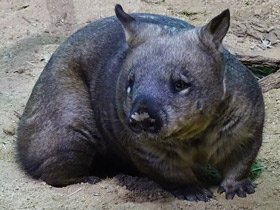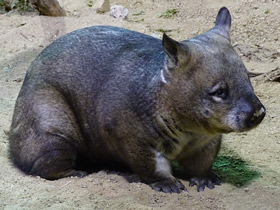The genus Lasiorhinus (hairy-nosed wombats)
The southern hairy-nosed wombat (Lasiorhinus latifrons)
Lasiorhinus is the genus containing the two extant hairy-nosed wombats, which are found in Australia. The southern hairy-nosed wombat is found in some of the semiarid to arid regions belt from New South Wales southwest to the South Australia-Western Australia border. The IUCN categorises it as Near Threatened. Conversely, the northern hairy-nosed wombat is categorised as Critically Endangered and only survives in a 3-square-kilometre (1.2 sq mi) range within the Epping Forest National Park in Queensland, but formerly also existed in Victoria and New South Wales.
Species
The genus includes the following species:
- Lasiorhinus krefftii;
- Lasiorhinus latifrons.
Fossils
- †Lasiorhinus angustidens (fossil).
Lasiorhinus is a genus of diprotodontid marsupials in the family Vombatidae commonly known as hairy-muzzled uombats.
Lasiorhinus are found in south-eastern South Australia, western Victoria, south-western New South Wales and central and southern Queensland. They inhabit woodland and savannah on the plains and in mountainous regions. Lasiorhinus are quite large animals.
Their body length is 77 to 100 cm, their tail 25 to 60 mm and their weight 19 to 32 kg. Their coat is long and soft.
The back is usually brownish-grey; the chest and cheeks are usually white.
The head is smaller than that of Vombatus ursinus. Above the eyes there are usually white patches. The ears are small, triangular in shape.
Pregnancy in Lasiorhinus lasts 20-22 days and usually produces one young, although twins are sometimes born. Young Lasiorhinus do not leave their mother's pouch until their eighth month of life.
The southern hairy-nosed wombat (Lasiorhinus latifrons)
The southern hairy-nosed wombat (Lasiorhinus latifrons) is one of three extant species of wombats. It is found in scattered areas of semiarid scrub and mallee from the eastern Nullarbor Plain to the New South Wales border area. It is the smallest of all three wombat species. The young often do not survive dry seasons. It is the state animal of South Australia.
Among the oldest southern hairy-nosed wombats ever documented were a male and a female from Brookfield Zoo just outside Chicago. Their names were Carver, who lived to be 34, and his mother, Vicky, who lived to be 24. In South Australia in 2010, a tame wombat named Wally was also reported as having reached the age of 34. Hamlet, a wombat at the Toronto Zoo, similarly died at age 34.
Taxonomy
English naturalist Richard Owen described the species in 1845. There are three synonyms:
- Phascolomys lasiorhinus Gould, 1863;
- Lasiorhinus mcoyi Gray, 1863;
- Phascolomys latifrons Owen, 1845.
Appearance
Lasiorhinus latifrons is a species of marsupial diprotodontid in the family Vombatidae found on the Nullarbor Plain (South Australia and southern Western Australia), and in New South Wales. It is the state animal of South Australia.
Lasiorhinus latifrons is the smallest of its siblings, measuring up to 1 m long and weighing 30-40 kg. It is only found in the dry areas of South Australia (Gowler Rangers, southern Nullabor and western Penong in south-eastern Western Australia, although the distribution of these marsupials was previously much wider.
Lasiorhinus latifrons is dense, with short, thick limbs with short, flat claws and a short tail. The body proportions of Lasiorhinus latifrons give it away as a swarm animal: the head is large and broad, the eyes small and the ears pointed.
The dental system is similar to that of rodents: the molars are rootless and grow throughout life, and there are no canines. Lasiorhinus latifrons, like all members of the suborder Diciliiformes, has the second and third toes of the hind limbs fused to form a single toe with a bifurcated claw. Lasiorhinus latifrons uses this double claw to scratch and clean its fur.
Life style
A silky grey or yellowish-brown coat covers the entire body of Lasiorhinus latifrons, including the nose, hence one of its names. Lasiorhinus latifrons currently occupies the same ecological niche as the marmot on other continents. Lying on its side, Lasiorhinus latifrons digs long burrows, up to thirty metres long, but usually shorter. These burrows are so wide that a pup crawling into the burrow can reach the entrance to a habitable chamber deep inside.
Lasiorhinus latifrons live in small communities of 5-10 animals of both sexes occupying the same tunnel system. The central sector is inhabited by males, while females occupy smaller pits within a radius of 150 metres. Lasiorhinus latifrons sleep in their burrows most of the day and forage at night. Lasiorhinus latifrons mark their burrows with faeces and by scent, rubbing their backs and hindquarters against nearby objects.
Behaviour and reproduction
Lasiorhinus latifrons communicate with each other using their sense of smell and hearing. Adult males may fight for territory, inflicting relatively serious injuries on each other. There is an age hierarchy among males in the same colony.
Being slow by nature, Lasiorhinus latifrons show inexhaustible energy during play. They are capable of running at 40 km/h and their strength has earned them the nickname "jungle bulldozers".
Lasiorhinus latifrons breed at any time of the year, but most young are born between September and December. Males can be aggressive during the breeding season. Lasiorhinus latifrons breeds under favourable feeding conditions and with sufficient rainfall. Otherwise, the bodies of males and females are not ready for the breeding mission, and the decision is postponed until better times.
Mating takes place in underground tunnels. Twenty-two days after fertilisation, the female Lasiorhinus latifrons gives birth to an embryonic offspring (most births occur in October). Females have a pouch (in the form of a fold of skin) in which two teats open. Usually only one calf is born, which crawls into the mother's pouch and attaches itself to one of the two teats. The calf remains in the mother's pouch until it is 6-9 months old, after which it leaves the pouch but continues to follow its mother for almost a year. At one year of age it stops receiving milk and at three years of age it reaches the size of an adult animal, becoming fully independent and sexually mature.
Nutrition
Lasiorhinus latifrons is mainly nocturnal and feeds on roots, bark, mushroom fruits, perennial grasses and sedges. In the absence of regular food, they may forage on mixed grasses and eat the leaves of woody shrubs. Lasiorhinus latifrons are more adapted to chewing food with their teeth than the eastern grey kangaroo (Macropus giganteus), which inhabits the same areas.
By inhabiting dry areas, Lasiorhinus latifrons have adapted to retain water in their bodies. On a hot day, these animals like to lie in cool pits, thus reducing their body temperature and metabolic rate, which are somewhat lower in Lasiorhinus latifrons than in its counterpart, Vombatus ursinus.
The digestive tract of Lasiorhinus latifrons has a small caecum and an impressive colon. In the comparatively small anterior part, fermentation of ingested food takes place, while in the large posterior part, water extraction takes place, so that the animal's faeces are very dry. This is an adaptation to life in an arid area, where the waste of water is unacceptable.
Communication
Southern hairy-nosed wombats use vocalisations and scents for communication. While most communication between wombats occurs through olfaction and scent-marking, as they do not often encounter each other directly, they emit rough, coughing noises when they pass each other, and emit a more strident call for alarm.
Conservation status
The southern hairy-nosed wombat was listed as Near Threatened by the IUCN in 2016, because "many subpopulations are now isolated and may be non-viable". It was previously listed as Least Concern because "While there are sporadic outbreaks of sarcoptic mange, competition with introduced herbivores, susceptibility to drought, and severe fragmentation in parts of its range, the species has a wide distribution, large population, occurs in a number of protected areas, and it is unlikely to be declining at nearly the rate required to qualify for listing in a threatened category". Wombats were hunted by aboriginal people for their meat. However, capturing a wombat takes considerable time and energy, so they were not hunted too frequently. The indigenous people of Australia value the wombat culturally and keep their local wombat populations healthy by hunting wombats in other areas.
Wombats have been considered as agricultural pests by landholders. Their digging can destroy crops and can increase the risk of livestock breaking their legs by falling through their burrow systems. Competition between livestock, rabbits, and wombats can lead to overgrazing. Overgrazing and the spread of invasive weeds in some areas has led to the flora being dominated by annual grass and weed species, from which wombats cannot get enough of their metabolic needs, resulting in reports of emaciation and mass starvation. The competition from introduced rabbits threatens the survival of wombats.

















































